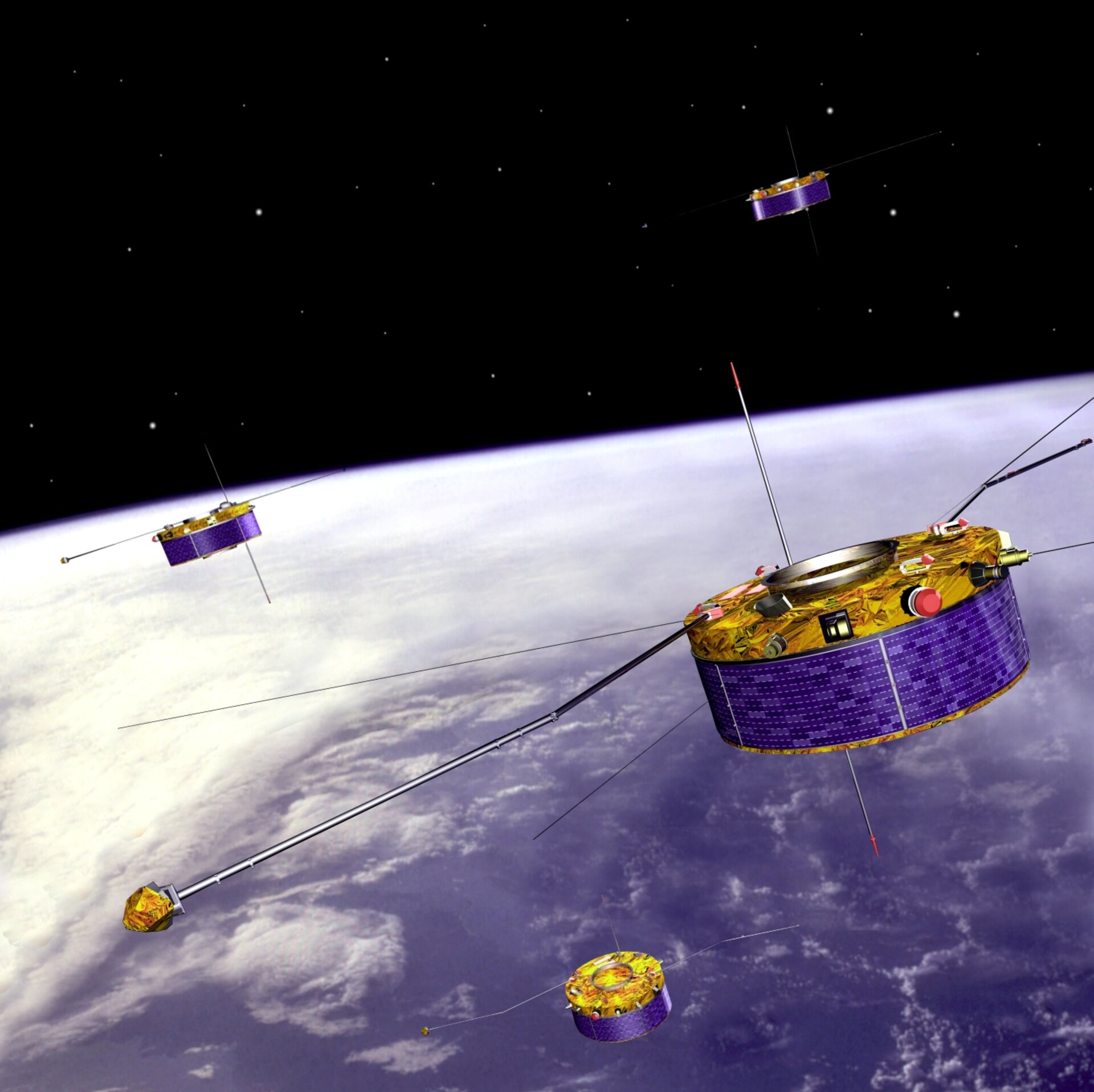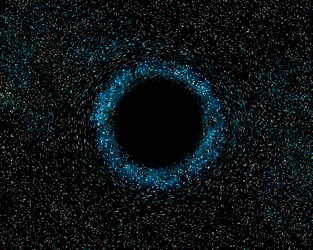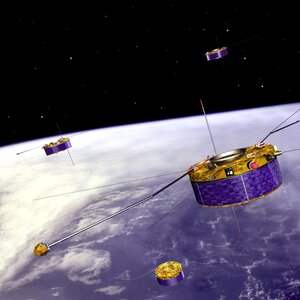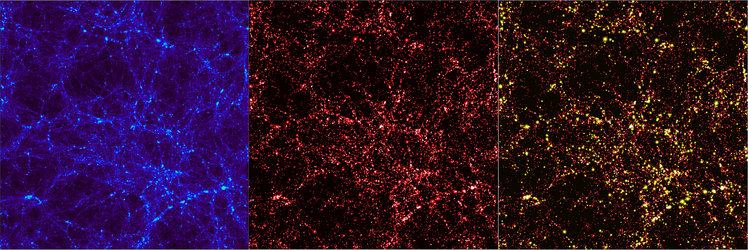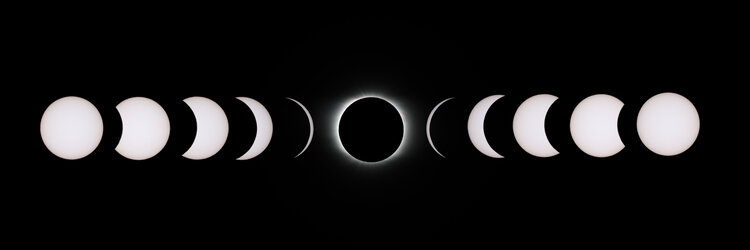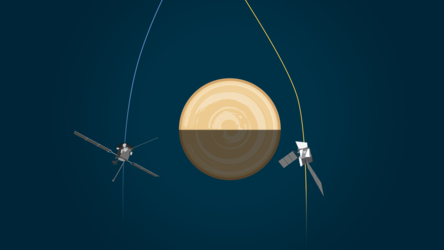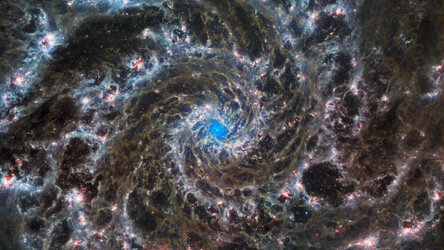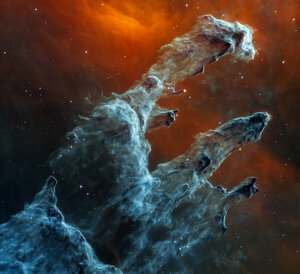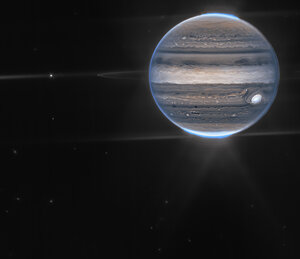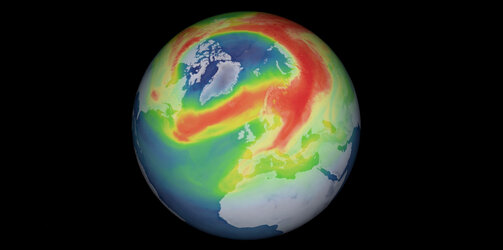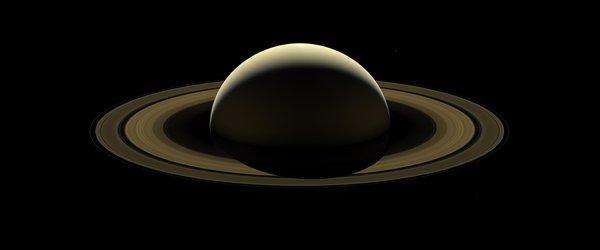C
Capture orbit
The first orbit of a spacecraft after it has been captured by the gravitational attraction of a celestial body. The capture is achieved by reducing the speed of the spacecraft. See also Orbit acquisition.
Carbonaceous compounds
Material containing carbon or carbon compounds.
Cassegrain telescope
Popular design for large, two-mirror reflecting telescopes in which the primary mirror has a concave parabolic shape and the secondary mirror has a convex hyperbolic shape. A hole in the primary allows the image plane to be located behind the large mirror.
Cassini division
A gap in Saturn's rings that divides the outer set from the inner set of rings.
Cataclysmic variable
A binary star system containing a white dwarf that exhibits sudden outbursts of energy.
Celsius (°C)
Scale of temperature for which water freezes at 0 degrees and boils at 100 degrees (under standard conditions).
Centaur (rocket)
A launcher; the rocket used to launch the Cassini-Huygens spacecraft.
Cepheid variable
Cepheid variables are a particular class of star which vary regularly and continuously in luminosity.
Charged particles
Particles with positive or negative charge, for example electrons, protons or ions.
Checkout
A test procedure needed to assess the correct functioning of a spacecraft's performances.
Chromosphere
Layer of the Sun's atmosphere located above the photosphere and below the corona. It is about 10 000 km deep and consists mainly of ionised hydrogen, helium and calcium. Its temperature ranges from 6000 °C at the photosphere boundary to 100 000 °C at the boundary with the corona. Its low density means it is usually only visible during a total solar eclipse.
67P/Churyumov-Gerasimenko (comet)
Comet 67P/Churyumov-Gerasimenko was selected as the new target for ESA’s Rosetta mission in May 2003.
It was discovered by Klim Churymov in photographs of 32P/Comas Solá taken by Svetlana Gerasimenko on 22 October 1969. Churyumov was measuring the positions of Comet Comas Sola and discovered that, in one image, it was 2 degrees out of position. On investigating, he realised that the object that he had thought was Comas Solá was, in fact, a new comet. He soon found a second image of this new comet on a plate taken on 9 September. The comet has been seen in 1969 (discovery), 1976, 1982, 1989, 1996 and now 2002. The period is 6.57 years an its nucleus comparatively large, estimated as 5 km in diameter. It reaches a magnitude around 12 normally. It is unusually active for a short-period object and has a coma and often tail even at perihelion, but despite this, even at the peak of outburst, the dust production rate is some 40 times lower than for 1P/Halley.
Even so, 67P/Churyumov-Gerasimenko is classed as a dusty comet and is joined in this group by objects such as 1P/Halley, 4P/Faye, 21P/Giacobini-Zinner and 22P/Kopff, as well as non-periodic objects such as C/1975 V1 (West), C/1995 O1 (Hale-Bopp) and C/1996 B2 (Hyakutake).
Climatology
The study of climate – the prevailing atmospheric conditions of humidity, temperature, winds, etc.
Closed Universe
See Critical density.
Cluster mission
ESA cornerstone mission to explore the interaction between the Sun and the Earth's magnetosphere. Launched in July (Salsa and Samba) and August (Rumba and Tango) 2000. The four spacecraft fly in tetrahedral formation in order to study electrical and magnetic phenomena both inside the magnetosphere and in the solar wind `upstream' of the Earth. See http://sci.esa.int/cluster/
Cosmic Microwave Background (CMB) radiation
Diffuse electromagnetic radiation that fills the entire Universe. Believed to be the remnant radiation from the Big Bang, which created the Universe 12-15 billion years ago. Its temperature has now cooled to 2.73 degrees above absolute zero (2.73 K). Discovered in 1964 by Arno Penzias and Robert Wilson. Space and ground-based observations show ripples in the radiation which are believed to be the first signs of structure emerging in the early Universe.
Coast phase
The period in which a spacecraft starts approaching its target.
Coded mask
Mask made for example of lead, tungsten, aluminium, etc. with a pattern of opaque and transparent elements. Coded masks are used for gathering powerful gamma radiation that cannot be focused by lenses or mirrors. A coded mask telescope is a pinhole camera but with many holes. The coded mask is placed above a detector. The gamma rays project the shadow of the mask onto the detector plane. By analysing the detected pattern of light and shadow an image of the sky can be obtained.
Coma
(1) Cloud of gas and dust surrounding a comet nucleus. Caused by vapourisation of the nucleus and emission of jets containing gas and dust. It grows in size as the comet approaches the Sun and may be up to one million kilometres across soon after the comet reaches perihelion.
(2) Lens aberration that gives an image a 'tail'.
Comet
Icy body which orbits the Sun. Thought to be leftover planetesimals from the formation of planets in the outer Solar System. The small, solid nucleus consists of water and other ices coated with dark organic compounds. As the nucleus approaches the Sun, it vapourises, creating a coma and two main tails. These tails – one made of gas and one of dust – may stream million of kilometres into space, and almost always point away from the Sun. Some 'dead' comets, which no longer display a coma or tails, resemble asteroids.
Compton scattering (and inverse compton scattering)
If a photon encounters a charged particle it may transfer some of its momentum to the electron and is then scattered away with reduced energy, i.e. a longer wavelength. The inverse process may happen if a photon encounters a very fast electron. It may then gain energy and can be boosted to shorter wavelengths.
Concave
Curved inwards (as opposed to convex), as in certain mirrors.
Conductivity, thermal
A measure of the ability of a body to conduct heat.
Convection
Transport of heat through movement of a gas or liquid.
Convection model
A heat transport model based on convection, in which the energy is transported by means of motion.
Convex
Surface curved like the outside of a circle.
Core
The central region of a star, planet or galaxy. In the case of a star or planet, it is usually the hottest, most dense part e.g. the iron-rich core at the centre of the Earth. In galaxies, it is the most luminous region which contains the largest concentration of matter – often with a black hole at the centre.
Cornerstone
Category name given to the European Space Agency's key missions in its long-term space science programmes Horizon 2000 and Horizon 2000+.
Corona
The outermost part of the Sun's atmosphere. It extends outwards for several times the Sun's radius and consists of extremely hot plasma which may exceed one million degrees Celsius. Normally only visible as a white halo during a total solar eclipse. Usually seen as streamers or filaments flowing away from the Sun, but sometimes it almost disappears in regions known as coronal holes.
Coronal mass ejection (CME)
An outward eruption of billions of tonnes of material thrown into space from the Sun's corona. Caused by magnetic storms on the Sun. The most energetic of all solar explosions, they send material at high speed (200 - 400 km/s) into space, and have a great influence on the magnetosphere. They are most frequent around the time of solar maximum.
Coronagraph
Device fitted to a telescope that blocks out the bright disc of a star, allowing the star's corona to be viewed.
Cosmic Background Explorer (COBE) satellite
A NASA satellite launched in 1989 to observe the cosmic microwave background. In 1992, COBE detected for the first time minute variations of temperature (the anisotropies) in the cosmic microwave background.
Cosmic rays
Highly energetic nuclei and particles, generally electrically charged, with energies ranging from 100 million eV to 10 million billion eV. Part of this radiation comes from the Sun, interstellar space, and intergalactic space. When a cosmic ray collides with our atmosphere a shower of secondary particles is created in the upper atmosphere. This air shower triggers a cascade of particle reactions and interactions which propagate to the ground.
Cosmology
Cosmology is the study of the Universe as a whole. Cosmological models are usually based on the cosmological principle which states that any observer in any galaxy sees the same general features of the Universe as any other. Based upon the concepts of homogeneity (matter is uniformly spread throughout space), isotropy (the Universe looks the same no matter in which direction one looks), and universality (the laws of physics that work on Earth work the same in every part of the Universe).
Crater
Basin-shaped depression in the surface of a planet or moon. May be caused by a comet or asteroid impact, or by a volcanic eruption. Usually circular as seen from above, impact craters often have a raised rim formed from material (ejecta) thrown out by the collision. Larger impact craters have central mountain peaks. Volcanic craters may contain lava which is supplied from subsurface magma. They are surrounded by material produced during previous volcanic eruptions.
Critical density
The current expansion of the Universe will be stopped in the future if the density of all the existing matter amounts to a particular value. That precise value for the total density of the Universe is called the 'critical density'. If the Universe has precisely the critical density it is a 'flat universe' (also called 'Euclidean universe').
If the density of the Universe is larger than the critical density, then not only will the expansion be stopped but there will be a collapse of the Universe some time in the future. The Universe will 'implode' under its own gravitational pull, an event called the 'Big Crunch'. This is referred to as a 'closed Universe'.
There is yet a third possibility: if the density of the total mass in the Universe is smaller than the critical density, the expansion will continue forever. This last possibility is what scientists call an 'open Universe'.
The critical density is calculated to be about (1-2) x 10-26 kg/m3. This is about 100 times larger than the average density inferred to be present in visible matter, such as stars and galaxies. Many scientists believe that the Universe should have the critical density and so there is a dark matter problem, in the sense that there should be much more mass present in the Universe in forms we have not yet detected.
Cruise phase
The phase of a spacecraft's journey needed to reach its target.
Crust
The solid surface layer of a planet or moon. In the inner Solar System, it is usually made of rock, while in the outer Solar System it is usually water-ice. The crust formed early in the planet's history, when it was still completely molten. Lighter materials 'floated' to the surface and formed the crust, leaving denser elements to form the core.
Cryostat
Container used to isolate thermally a fluid from its environment and maintain it at low temperatures.
Cygnus X-1
Source of intense X-ray radiation, discovered in 1965 in the Cygnus constellation. It is believed to be a black hole system.
Cygnus X-3
Source of intense X-ray radiation in the Cygnus constellation which is associated with a compact binary system in which two stars revolve around each other in less than 5 hours.















 Germany
Germany
 Austria
Austria
 Belgium
Belgium
 Denmark
Denmark
 Spain
Spain
 Estonia
Estonia
 Finland
Finland
 France
France
 Greece
Greece
 Hungary
Hungary
 Ireland
Ireland
 Italy
Italy
 Luxembourg
Luxembourg
 Norway
Norway
 The Netherlands
The Netherlands
 Poland
Poland
 Portugal
Portugal
 Czechia
Czechia
 Romania
Romania
 United Kingdom
United Kingdom
 Slovenia
Slovenia
 Sweden
Sweden
 Switzerland
Switzerland

























